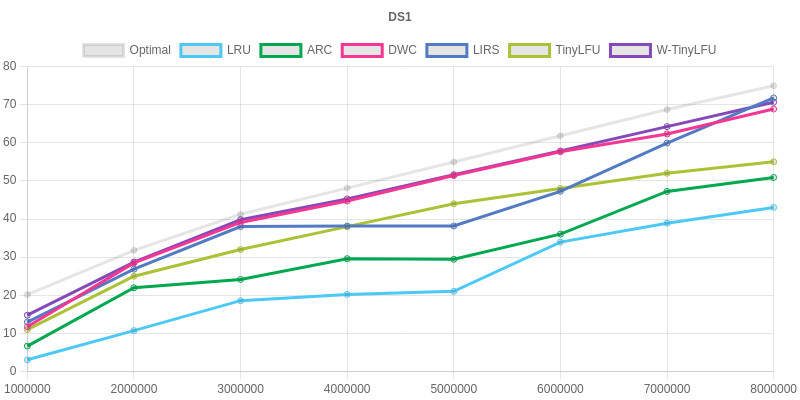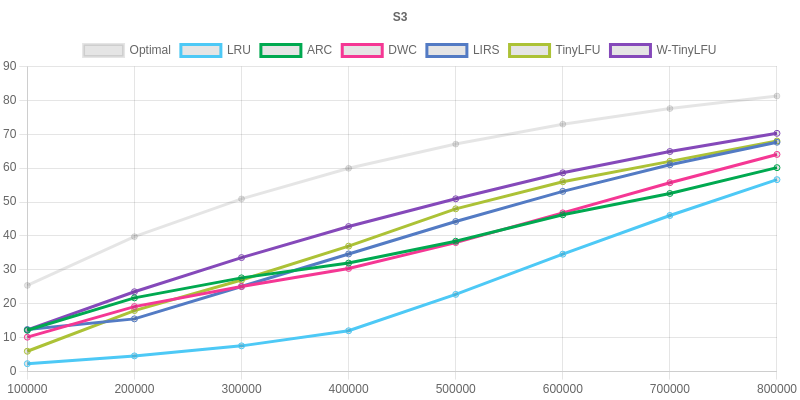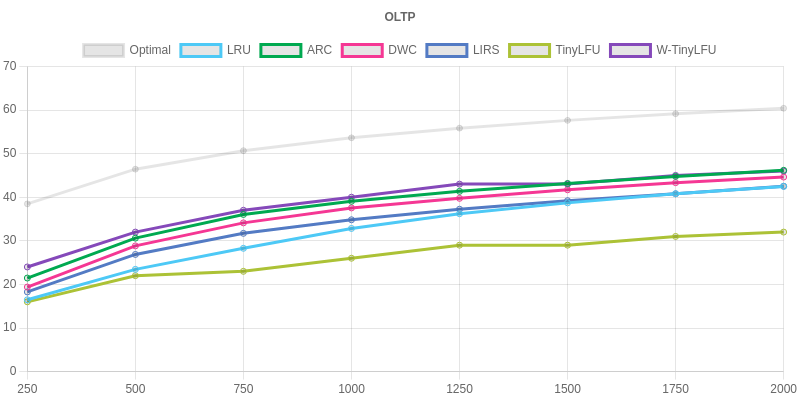Dual Window Cache

The highest performance constant complexity cache algorithm.
Maintenance
The source code is maintained on the next source repository.
https://github.com/falsandtru/spica
Efficiency
Mathematical efficiency
Some different cache algorithms require extra memory space to retain evicted keys.
Linear time complexity indicates the existence of batch processing.
Note that admission algorithm doesn't work without eviction algorithm.
| Algorithm | Type | Time complexity
(Worst case) | Space complexity
(Extra) | Key size | Data structures |
|---|
| LRU | Evict | Constant | Constant | 1x | 1 list |
| DWC | Evict | Constant | Constant | 1x | 2 lists |
| ARC | Evict | Constant | Linear | 2x | 4 lists |
| LIRS | Evict | Linear | Linear | 3-2500x | 2 lists |
| TinyLFU | Admit | Linear | Linear | ~1-10x
(8bit * 10N * 4) | 5 arrays |
| W-TinyLFU | Admit | Linear | Linear | ~1-10x
(8bit * 10N * 4) | 1 list
4 arrays |
https://github.com/ben-manes/caffeine/wiki/Efficiency
https://github.com/zhongch4g/LIRS2/blob/master/src/replace_lirs_base.cc
Engineering efficiency
A pointer is 8 bytes, bool and int8 are each 1 byte in C.
8 byte key and value (int64, float64, 8 chars)
Memoize, etc.
| Algorithm | Entry overhead | Key size | Total per entry | Attenuation coefficient |
|---|
| LRU | 16 bytes | 1x | 32 bytes | 100.00% |
| ARC | 18 bytes | 2x | 60 bytes | 53.33% |
| DWC | 18 bytes | 1x | 34 bytes | 94.11% |
| (LIRS) | 35 bytes | 3x | 137 bytes | 23.35% |
| (LIRS) | 35 bytes | 10x | 438 bytes | 7.30% |
| (TinyLFU) | 56 bytes | 1x | 72 bytes | 44.44% |
| W-TinyLFU | 56 bytes | 1x | 72 bytes | 44.44% |
128 byte key and 8 byte value (Session ID / ID, index)
In-memory KVS, etc.
| Algorithm | Entry overhead | Key size | Total per entry | Attenuation coefficient |
|---|
| LRU | 16 bytes | 1x | 152 bytes | 100.00% |
| ARC | 18 bytes | 2x | 300 bytes | 50.66% |
| DWC | 18 bytes | 1x | 154 bytes | 98.70% |
| (LIRS) | 35 bytes | 3x | 497 bytes | 30.58% |
| (LIRS) | 35 bytes | 10x | 1,638 bytes | 9.27% |
| (TinyLFU) | 56 bytes | 1x | 192 bytes | 79.16% |
| W-TinyLFU | 56 bytes | 1x | 192 bytes | 79.16% |
16 byte key and 512 byte value (Domain / DNS packet)
DNS cache server, etc.
| Algorithm | Entry overhead | Key size | Total per entry | Attenuation coefficient |
|---|
| LRU | 16 bytes | 1x | 544 bytes | 100.00% |
| ARC | 18 bytes | 2x | 580 bytes | 93.37% |
| DWC | 18 bytes | 1x | 546 bytes | 99.63% |
| (LIRS) | 35 bytes | 3x | 665 bytes | 81.80% |
| (LIRS) | 35 bytes | 10x | 1,022 bytes | 53.22% |
| (TinyLFU) | 56 bytes | 1x | 584 bytes | 93.15% |
| W-TinyLFU | 56 bytes | 1x | 584 bytes | 93.15% |
Resistance
LIRS's burst resistance means the resistance to continuous cache misses for the last LIR entry or the HIR entries.
| Algorithm | Type | Scan | Loop | Burst |
|---|
| LRU | Evict | | | ✓ |
| DWC | Evict | ✓ | ✓ | ✓ |
| ARC | Evict | ✓ | | ✓ |
| LIRS | Evict | ✓ | ✓ | |
| TinyLFU | Admit | ✓ | ✓ | |
| W-TinyLFU | Admit | ✓ | ✓ | ✓ |
Strategies
- Dynamic partition
- Sampled history injection
- Transitive wide MRU with cyclic replacement
Properties
Generally superior and almost flawless.
- Highest performance
- High hit ratio (DS1, S3, OLTP, GLI)
- Highest hit ratio of all the general-purpose cache algorithms.
- Approximate to W-TinyLFU (DS1, GLI).
- Approximate to ARC (S3, OLTP).
- W-TinyLFU is basically not a general-purpose cache algorithm due to some problems.
- W-TinyLFU is not a general-purpose cache algorithm without dynamic window and incremental reset.
- W-TinyLFU is impossible to efficiently implement without pointer addresses or fast hash functions.
- W-TinyLFU's benchmark settings are not described (Especially suspicious with OLTP).
- Highest engineering hit ratio of all the general cache algorithms.
- As a result of engineering efficiency.
- Low time overhead (High throughput)
- Low latency
- Constant time complexity.
- No batch processing like LIRS and TinyLFU.
- Parallel suitable
- Separated lists are suitable for lock-free processing.
- Efficient
- Low memory usage
- Largest capacity per memory size of all the advanced cache algorithms.
- Constant extra space complexity.
- Retain only keys of resident entries (No history).
- Immediate release of evicted keys
- Primary cache algorithm in the standard library must release memory immediately.
- Low space overhead
- Add only two smallest fields to entries.
- High resistance
- Scan, loop, and burst resistance
- Few tradeoffs
- Not the highest mathematical hit ratio
- Highest hit ratio of each workload are resulted by W-TinyLFU or ARC.
- Statistical accuracy dependent
- Very smaller cache size than sufficient can degrade hit ratio.
Tradeoffs
Note that LIRS and TinyLFU are risky cache algorithms.
- LRU
- Low performance
- No resistance
- Scan access clears all entries.
- ARC
- Middle performance
- Inefficient
- High overhead
- Few resistance
- DWC
- Not the highest mathematical hit ratio
- Statistical accuracy dependent
- LIRS
- Extremely inefficient
- Spike latency
- Bulk deletion of low-frequency entries takes linear time.
- Vulnerable algorithm
- Continuous cache misses for the last LIR entry or the HIR entries explode key size.
- TinyLFU
- Incomplete algorithm
- TinyLFU is just a vulnerable incomplete base-algorithm of W-TinyLFU.
- Burst access saturates Bloom filters.
- TinyLFU is worse than LRU in theory.
- Language dependent
- Impossible to efficiently implement without pointer addresses or fast hash functions.
- High overhead
- Read and write average 40 array elements per access.
- Restricted delete operation
- Bloom filters don't support delete operation.
- Frequent delete operations degrade performance.
- Spike latency
- Whole reset of Bloom filters takes linear time.
- Vulnerable algorithm
- Burst access degrades performance.
- W-TinyLFU
- Language dependent
- Impossible to efficiently implement without pointer addresses or fast hash functions.
- High overhead
- Read and write average 40 array elements per access.
- Restricted delete operation
- Bloom filters don't support delete operation.
- Frequent delete operations degrade performance.
- Spike latency
- Whole reset of Bloom filters takes linear time.
Hit ratio
Note that another cache algorithm sometimes changes the parameter values per workload to get a favorite result as the paper of TinyLFU has changed the window size of W-TinyLFU.
- DWC's results are measured by the same default parameter values.
- TinyLFU's results are the traces of Ristretto.
- W-TinyLFU's results are the traces of Caffeine.
- Set the datasets to
./benchmark/trace (See ./benchmark/ratio.ts). - Run
npm i. - Run
npm run bench. - Click the DEBUG button to open a debug tab.
- Close the previous tab.
- Press F12 key to open devtools.
- Select the console tab.
https://github.com/dgraph-io/benchmarks
https://github.com/ben-manes/caffeine/wiki/Efficiency
https://github.com/dgraph-io/ristretto
https://docs.google.com/spreadsheets/d/1G3deNz1gJCoXBE2IuraUSwLE7H_EMn4Sn2GU0HTpI5Y (https://github.com/jedisct1/rust-arc-cache/issues/1)
DS1

W-TinyLFU > DWC > (LIRS) > (TinyLFU) > ARC > LRU
- DWC is an approximation of W-TinyLFU.
DS1 1,000,000
LRU hit ratio 3.08%
DWC hit ratio 11.77%
DWC - LRU hit ratio delta 8.69%
DWC / LRU hit ratio rate 381%
DS1 2,000,000
LRU hit ratio 10.74%
DWC hit ratio 28.50%
DWC - LRU hit ratio delta 17.75%
DWC / LRU hit ratio rate 265%
DS1 3,000,000
LRU hit ratio 18.59%
DWC hit ratio 39.09%
DWC - LRU hit ratio delta 20.50%
DWC / LRU hit ratio rate 210%
DS1 4,000,000
LRU hit ratio 20.24%
DWC hit ratio 44.72%
DWC - LRU hit ratio delta 24.48%
DWC / LRU hit ratio rate 220%
DS1 5,000,000
LRU hit ratio 21.03%
DWC hit ratio 51.39%
DWC - LRU hit ratio delta 30.36%
DWC / LRU hit ratio rate 244%
DS1 6,000,000
LRU hit ratio 33.95%
DWC hit ratio 57.64%
DWC - LRU hit ratio delta 23.68%
DWC / LRU hit ratio rate 169%
DS1 7,000,000
LRU hit ratio 38.89%
DWC hit ratio 62.30%
DWC - LRU hit ratio delta 23.40%
DWC / LRU hit ratio rate 160%
DS1 8,000,000
LRU hit ratio 43.03%
DWC hit ratio 68.83%
DWC - LRU hit ratio delta 25.79%
DWC / LRU hit ratio rate 159%
S3

W-TinyLFU > (TinyLFU) > (LIRS) > DWC, ARC > LRU
- DWC is an approximation of ARC.
S3 100,000
LRU hit ratio 2.32%
DWC hit ratio 10.15%
DWC - LRU hit ratio delta 7.83%
DWC / LRU hit ratio rate 436%
S3 200,000
LRU hit ratio 4.63%
DWC hit ratio 19.17%
DWC - LRU hit ratio delta 14.54%
DWC / LRU hit ratio rate 414%
S3 300,000
LRU hit ratio 7.58%
DWC hit ratio 25.12%
DWC - LRU hit ratio delta 17.53%
DWC / LRU hit ratio rate 331%
S3 400,000
LRU hit ratio 12.03%
DWC hit ratio 30.42%
DWC - LRU hit ratio delta 18.38%
DWC / LRU hit ratio rate 252%
S3 500,000
LRU hit ratio 22.76%
DWC hit ratio 38.04%
DWC - LRU hit ratio delta 15.27%
DWC / LRU hit ratio rate 167%
S3 600,000
LRU hit ratio 34.63%
DWC hit ratio 46.81%
DWC - LRU hit ratio delta 12.18%
DWC / LRU hit ratio rate 135%
S3 700,000
LRU hit ratio 46.04%
DWC hit ratio 55.70%
DWC - LRU hit ratio delta 9.66%
DWC / LRU hit ratio rate 120%
S3 800,000
LRU hit ratio 56.59%
DWC hit ratio 64.04%
DWC - LRU hit ratio delta 7.44%
DWC / LRU hit ratio rate 113%
OLTP

W-TinyLFU > ARC > DWC > (LIRS) > LRU > (TinyLFU)
- DWC is an approximation of ARC.
OLTP 250
LRU hit ratio 16.47%
DWC hit ratio 19.39%
DWC - LRU hit ratio delta 2.92%
DWC / LRU hit ratio rate 117%
OLTP 500
LRU hit ratio 23.44%
DWC hit ratio 28.83%
DWC - LRU hit ratio delta 5.39%
DWC / LRU hit ratio rate 122%
OLTP 750
LRU hit ratio 28.28%
DWC hit ratio 34.11%
DWC - LRU hit ratio delta 5.83%
DWC / LRU hit ratio rate 120%
OLTP 1,000
LRU hit ratio 32.83%
DWC hit ratio 37.54%
DWC - LRU hit ratio delta 4.71%
DWC / LRU hit ratio rate 114%
OLTP 1,250
LRU hit ratio 36.20%
DWC hit ratio 39.74%
DWC - LRU hit ratio delta 3.53%
DWC / LRU hit ratio rate 109%
OLTP 1,500
LRU hit ratio 38.69%
DWC hit ratio 41.70%
DWC - LRU hit ratio delta 3.00%
DWC / LRU hit ratio rate 107%
OLTP 1,750
LRU hit ratio 40.78%
DWC hit ratio 43.33%
DWC - LRU hit ratio delta 2.54%
DWC / LRU hit ratio rate 106%
OLTP 2,000
LRU hit ratio 42.46%
DWC hit ratio 44.62%
DWC - LRU hit ratio delta 2.16%
DWC / LRU hit ratio rate 105%
GLI

W-TinyLFU, (LIRS) > DWC > (TinyLFU) >> ARC > LRU
- DWC is an approximation of W-TinyLFU.
GLI 250
LRU hit ratio 0.93%
DWC hit ratio 16.32%
DWC - LRU hit ratio delta 15.39%
DWC / LRU hit ratio rate 1753%
GLI 500
LRU hit ratio 0.96%
DWC hit ratio 32.84%
DWC - LRU hit ratio delta 31.88%
DWC / LRU hit ratio rate 3406%
GLI 750
LRU hit ratio 1.16%
DWC hit ratio 41.35%
DWC - LRU hit ratio delta 40.19%
DWC / LRU hit ratio rate 3554%
GLI 1,000
LRU hit ratio 11.22%
DWC hit ratio 49.61%
DWC - LRU hit ratio delta 38.39%
DWC / LRU hit ratio rate 442%
GLI 1,250
LRU hit ratio 21.25%
DWC hit ratio 52.60%
DWC - LRU hit ratio delta 31.34%
DWC / LRU hit ratio rate 247%
GLI 1,500
LRU hit ratio 36.56%
DWC hit ratio 53.78%
DWC - LRU hit ratio delta 17.22%
DWC / LRU hit ratio rate 147%
GLI 1,750
LRU hit ratio 45.04%
DWC hit ratio 55.66%
DWC - LRU hit ratio delta 10.62%
DWC / LRU hit ratio rate 123%
GLI 2,000
LRU hit ratio 57.41%
DWC hit ratio 57.96%
DWC - LRU hit ratio delta 0.54%
DWC / LRU hit ratio rate 100%
Throughput
80-120% of lru-cache.
Note that the number of trials per capacity for simulation 1,000,000 is insufficient.
No result with 10,000,000 because lru-cache crushes with the next error on the next machine of GitHub Actions.
It is verified that the error was thrown also when benchmarking only lru-cache.
Of course it is verified that DWC works fine under the same condition.
Error: Uncaught RangeError: Map maximum size exceeded
System:
OS: Linux 5.15 Ubuntu 20.04.5 LTS (Focal Fossa)
CPU: (2) x64 Intel(R) Xeon(R) Platinum 8370C CPU @ 2.80GHz
Memory: 5.88 GB / 6.78 GB
Clock: spica/clock
ISCCache: lru-cache
LRUCache: spica/lru
DW-Cache: spica/cache
'Clock new x 1,328,833 ops/sec ±3.63% (113 runs sampled)'
'ISCCache new x 13,768 ops/sec ±1.00% (120 runs sampled)'
'LRUCache new x 27,168,783 ops/sec ±1.50% (122 runs sampled)'
'DW-Cache new x 6,049,201 ops/sec ±0.86% (122 runs sampled)'
'Clock simulation 100 x 13,493,137 ops/sec ±1.65% (121 runs sampled)'
'ISCCache simulation 100 x 8,651,793 ops/sec ±1.85% (121 runs sampled)'
'LRUCache simulation 100 x 10,604,646 ops/sec ±2.24% (120 runs sampled)'
'DW-Cache simulation 100 x 7,242,013 ops/sec ±1.65% (121 runs sampled)'
'Clock simulation 1,000 x 10,694,963 ops/sec ±1.81% (120 runs sampled)'
'ISCCache simulation 1,000 x 7,700,019 ops/sec ±1.90% (121 runs sampled)'
'LRUCache simulation 1,000 x 9,184,813 ops/sec ±2.13% (120 runs sampled)'
'DW-Cache simulation 1,000 x 7,041,470 ops/sec ±1.77% (120 runs sampled)'
'Clock simulation 10,000 x 10,517,215 ops/sec ±1.78% (122 runs sampled)'
'ISCCache simulation 10,000 x 7,365,593 ops/sec ±1.67% (121 runs sampled)'
'LRUCache simulation 10,000 x 8,685,666 ops/sec ±1.81% (121 runs sampled)'
'DW-Cache simulation 10,000 x 7,317,621 ops/sec ±1.42% (120 runs sampled)'
'Clock simulation 100,000 x 7,417,826 ops/sec ±1.60% (118 runs sampled)'
'ISCCache simulation 100,000 x 4,523,157 ops/sec ±1.22% (117 runs sampled)'
'LRUCache simulation 100,000 x 5,424,344 ops/sec ±2.10% (119 runs sampled)'
'DW-Cache simulation 100,000 x 4,190,537 ops/sec ±1.44% (113 runs sampled)'
'Clock simulation 1,000,000 x 4,519,623 ops/sec ±3.63% (106 runs sampled)'
'ISCCache simulation 1,000,000 x 2,081,961 ops/sec ±3.35% (101 runs sampled)'
'LRUCache simulation 1,000,000 x 2,686,808 ops/sec ±3.88% (103 runs sampled)'
'DW-Cache simulation 1,000,000 x 2,481,012 ops/sec ±2.54% (111 runs sampled)'
const key = random() < 0.9
? random() * capacity * 1 | 0
: random() * capacity * 9 + capacity | 0;
cache.get(key) ?? cache.set(key, {});
Comprehensive evaluation
Hit ratio
Mathematical
| Class | Algorithms |
|---|
| Very high | W-TinyLFU |
| High | DWC, (LIRS) |
| Middle | ARC, (TinyLFU) |
| Low | LRU |
Engineering
| Class | Algorithms |
|---|
| High | DWC |
| Middle | LRU |
| Low | W-TinyLFU, (LIRS), ARC, (TinyLFU) |
Efficiency
| Total per entry | Algorithm | Key size |
|---|
| 32 bytes | LRU | 1x |
| 34 bytes | DWC | 1x |
| 60 bytes | ARC | 2x |
| 72 bytes | W-TinyLFU | 1x |
| 72 bytes | (TinyLFU) | 1x |
| 137 bytes | (LIRS) | 3x |
| 438 bytes | (LIRS) | 10x |
Resistance
| Class | Effect | Algorithms |
|---|
| Total | High | W-TinyLFU, DWC |
| Most | High | (TinyLFU), (LIRS) |
| Few | Low | ARC |
| None | None | LRU |
Throughput
| Type | Algorithms |
|---|
| Dynamic lists (Lock-free) | DWC > (LIRS) > ARC |
| Bloom filter + Dynamic lists | (TinyLFU) |
| Dynamic lists + Bloom filter | W-TinyLFU |
| Static list | LRU |
Latency
| Worst time | Algorithms |
|---|
| Constant | LRU, DWC, ARC |
| Linear (1) | W-TinyLFU > (TinyLFU) |
| Linear (> 1) | (LIRS) |
Vulnerability
| Type | Algorithms |
|---|
| Degrade | (TinyLFU) |
| Crush | (LIRS) |
API
export namespace Cache {
export interface Options<K, V = undefined> {
readonly capacity?: number;
readonly resource?: number;
readonly age?: number;
readonly eagerExpiration?: boolean;
readonly disposer?: (value: V, key: K) => void;
readonly capture?: {
readonly delete?: boolean;
readonly clear?: boolean;
};
readonly window?: number;
readonly sample?: number;
readonly sweep?: {
readonly threshold?: number;
readonly ratio?: number;
readonly window?: number;
readonly room?: number;
readonly range?: number;
readonly shift?: number;
};
}
}
export class Cache<K, V> {
constructor(capacity: number, opts?: Cache.Options<K, V>);
constructor(opts: Cache.Options<K, V>);
add(key: K, value: V, opts?: { size?: number; age?: number; }): boolean;
add(this: Cache<K, undefined>, key: K, value?: V, opts?: { size?: number; age?: number; }): boolean;
put(key: K, value: V, opts?: { size?: number; age?: number; }): boolean;
put(this: Cache<K, undefined>, key: K, value?: V, opts?: { size?: number; age?: number; }): boolean;
set(key: K, value: V, opts?: { size?: number; age?: number; }): this;
set(this: Cache<K, undefined>, key: K, value?: V, opts?: { size?: number; age?: number; }): this;
get(key: K): V | undefined;
has(key: K): boolean;
delete(key: K): boolean;
clear(): void;
resize(capacity: number, resource?: number): void;
readonly length: number;
readonly size: number;
[Symbol.iterator](): Iterator<[K, V], undefined, undefined>;
}



